Capturing “Jove’s Autograph”: Late Nineteenth-Century Lightning Photography and Electrical Agency

On September 5, 1885, Scientific American published a photograph depicting a “streak of real ‘Jersey lightning,’” taken by William Nicholson Jennings (1860-1946) at 10:30 p.m. on the first of August that same year.1 Captured on the roof of Jennings’ house in North Philadelphia and later reproduced as a lantern slide (fig. 1), the photograph reveals a flash of lightning traveling diagonally from the upper right corner of the frame to the horizon, illuminating the tops of trees and a line of row house roofs in the foreground. Regional and national newspapers soon proclaimed Jennings as the first to successfully photograph lightning with a camera. Later that month, Philadelphia’s The Daily News reported that the “amateur photographer” was “in a fair way to become famous, while the expert professional who captures the lazy graces of the elephant and the anaconda and threatens to revolutionize our notions of animal life, may die before he gets a good sitting from a mule.”2 In this humorous anecdote, The Daily News compared Jennings’ achievement with the slow progress of Eadweard Muybridge (1830-1904), who labored at his motion studies project in the city at the same time.
While Jennings has not fared as well as Muybridge in terms of name recognition today, he too was deeply invested in capturing phenomena the human eye cannot accurately see without mechanical assistance.3 Jennings acknowledged “that the movements of a horse’s feet and legs in running and jumping were not understood by artists until the exact postures were caught by the camera, [but] no object has caused more discussion on the question whether or not we can trust the evidence of our senses, than the flash of lightning.”4 Photographic technology offered both Muybridge and Jennings a means to assert the authoritative truthfulness of their images in order to further knowledge of animal locomotion and meteorological events. Jennings’ images and correspondence demonstrate that he was keenly aware of the role of photography in contemporary debates regarding technology and the limits of human perception and objectivity in art.
Jennings’ ability to record lightning relied on invention; he only succeeded in photographing his subject in 1882 through the adaptation of specially designed “Rapid Eclipse Photo-plates” supplied by his friend, occasional business partner, and dry plate manufacturer John Carbutt (1832-1905).5 Jennings’ lightning photographs were also thoroughly enmeshed in shifting public perceptions of another new invention: electric lighting. Jennings successfully obtained his first photograph in 1882, only a year after the Brush Electric Light Company installed arc street lamps along Chestnut Street in Philadelphia. While S. Hollis Clayson and Hélène Valance have effectively explored how electricity and other new technologies transformed artistic visualizations of the night during the late nineteenth and early twentieth century, this paper argues that lightning photographs produced by Jennings and others reinforced the material agency of electricity at a moment when it was transformed from an unruly, violent force to become a useful power that could be pictorially harnessed, domesticated, utilized, and captured.6 In exploring the material impact and significance of lightning and electricity, I am inspired by recent work in new materialism, which, in the words of political theorist Jane Bennett, recognizes “the capacity of things—edibles, commodities, storms, metals—not only to impede or block the will and designs of humans but also to act as quasi agents or forces with trajectories, propensities, or tendencies of their own.”7 In her examination of the vast assemblage of human and nonhuman agents that precipitated a massive 2003 power blackout, Bennett describes electricity as a “stream of vital materialities called electrons . . . always on the move, always going somewhere, though where this will be is not entirely predictable.”8 The unpredictability of electricity—whether employed to illuminate city streets or hurtling through the stormy sky—played an important role in the production and reception of lightning photography and electric lights in the late nineteenth century.
Jennings was affiliated with a growing, international network of photographers and meteorological societies invested in the visual documentation of lightning. He and others attempted to use photography to challenge fine art representations of thunderbolts and identify lightning types. Ultimately, visual categorization proved untenable and unreliable, owing to the powerful material agency of lightning, which shaped and destroyed matter and lefts its own distinctive mark on photographic plates and even human skin. This disruptive force, revealed and promoted in Jennings’ photos and corresponding texts, informed public opinion about electric lights—or “chained lightning”—illuminating the city. This study is part of an ongoing research project investigating the relationship of lightning photography to shifting conceptions of space, time, objectivity, and electrical agency in the late nineteenth century.
Born in Yorkshire in 1860, Jennings immigrated to Philadelphia in 1879, after the Panic of 1876 bankrupted the family wool mill. He worked as a stenographer and typist at John Wanamaker’s new department store, and began experimenting with photography in 1881 using a 4 x 5 inch glass-plate camera. The Pennsylvania Railroad hired him as a surveyor in 1885. For that position, he documented construction sites, bridges, and tunnels in order to verify progress and protect the company from litigious lawsuits. His lightning photographs were only one aspect of a successful career in commercial photography. Jennings recorded the changing landscape of Philadelphia through photographs of buildings and street scenes, and he partnered with Frederick Ives (1856-1937) in the development of the photochromoscope, producing brightly hued images of tourist sites such as Yellowstone and Niagara Falls. He also took the first aerial photographs of the city, ascending above Philadelphia with the balloonist Samuel King on July 4, 1893. He was an active member of the Franklin Institute, an institution deeply invested in the promotion of emerging photographic and electrical technologies. Jennings deposited a scrapbook of his work on photographing lightning there in 1937, and it is this album, boldly titled “Jove’s Autograph,” that forms the foundation of this research. The layered media of this binder includes newspaper clippings, articles, and correspondence demonstrating a desire to both preserve the unpredictability and agential capacity of lightning while systematically attempting to capture and document its multiple forms.9
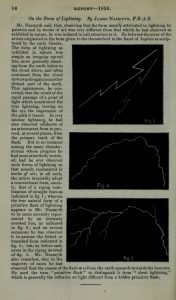
According to Jennings’ own personal narrative, he set out to photograph lightning in order to prove the inaccuracy of the “awkward angular zig-zag” populating artworks. In his scrapbook, he wrote, “To my eye [lightning] appeared with an infinite variety of outline; all of them graceful, none zig-zag.”10 Although he insisted this idea was original, James Nasmyth (1808-1890), the Scottish engineer and astronomer, likely inspired Jennings in his quest. In 1857, Nasmyth published a report visually comparing two sketches taken from firsthand observation with the offending artist’s conventional zigzag (fig. 2), and insisting that he had never “observed such forms of lightning as that usually represented in works of art.”11 To photographically prove this point, Jennings claimed he hauled a camera up to his roof during every storm for two years, but that his emulsion was not sensitive enough to record the “evanescent flash,” as he described it. On September 2, 1882, owing to Carbutt’s new photo plates, Jennings finally captured “a dazzling stream of electric light” (fig. 3).12 His photographs improved as he used more sensitive emulsions and “quicker” lenses with a larger maximum aperture, leading to the clearer image reproduced in Scientific American a few years later.13
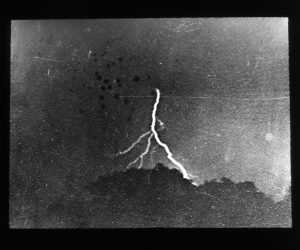
Despite his insistent declarations, Jennings was not actually the first to photograph lightning. The St. Louis photographer T. M. Easterly (1809-1882) is a more likely contender for this title, having fixed the meteorological phenomenon in a daguerreotype several decades earlier in 1847 (fig. 4). Reproduced as a cabinet card by Cramer, Gross, and Company, the image was displayed beside portrait likenesses of “prominent citizens, Indian chiefs, and Notorious Robbers and Murderers,” in Easterly’s St. Louis gallery, thereby positioning lightning, and its miraculous photographic arrest, as an object of exotic wonder.14Several photographers, including Robert Haensel in Germany, Charles Moussette in France, and New England meteorologist A. H. Binden successfully secured the elusive thunderbolt in the 1880s.15 Nonetheless, Jennings aggressively promoted and maintained throughout his life the designation for his 1882 photograph as the earliest on record.
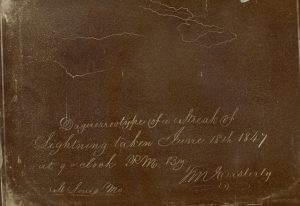
Jennings presented and disseminated his lightning images through different media and venues, positioning them as both popular entertainment and scientific specimens. He reproduced his photographs in the press, compiled them in scrapbooks, and offered curated lantern slide presentations in Philadelphia and New York. Jennings also produced stereoscopic views of lightning made with two small cameras placed about one hundred feet apart in order to “give more violent perspective.”16 At one Franklin Institute meeting, he circulated a number of these prints mounted in a hand stereoscope, providing members with a more immersive experience of his subject.17 Jennings enhanced the seductive qualities of his photographs by inviting viewers to imagine the ferocity of the storm. His script for one lantern slide presentation set the scene with “the close of a hot sultry day, when you are returning home with limp collar and dropping spirits” and you notice a “bank of dense curdling clouds” with “evidence of great internal strife.”18
While Jennings’ photographs entertained and captivated audiences, they were also aligned with a broader international interest in the photography and categorizing of meteorological phenomena in order to better understand and predict their occurrence and capacity for destruction.19 In the American Journal of Photography, meteorologist Alexander McAdie proposed that photography could help determine the dimensions and electrical energy of a lightning flash, thereby potentially facilitating its control.20 National weather services demonstrated particular investment in the collection and implementation of lightning and cloud studies. The United States Weather Bureau, officially established in 1890 under the Department of Agriculture, received many photographs of weather events, including images by Jennings, which they summarized in the Monthly Weather Review and displayed at the 1893 World’s Columbian Exposition in Chicago.21 The British Royal Meteorological Society (RMS) used photographs and firsthand observation to authoritatively assert the atmospheric inaccuracies of fine art. As photography historian Jennifer Tucker has demonstrated, the employment of photography by the RMS reveals the intimate entanglement of artistic visual practice and ideologies with scientific imaging and its reception in the late nineteenth century.22 In an 1895 address to the RMS, the astronomer and meteorologist Richard Inwards condemned a number of “weather fallacies” promoted by artists. To illustrate his presentation, Inwards compared a projected image of artist’s lightning with “a photograph taken direct from nature” in order to demonstrate that “the artist had very little understood the true form of the lightning flash.”23 Inwards upheld the photograph, “direct from nature,” as the more accurate record.
Jennings similarly targeted artists in his own campaign against inaccurate lightning representation. One unattributed newspaper clipping in his “Jove’s Autograph” scrapbook features a condemnation of the scene painter for the theatrical sensation, The Soudan, which enjoyed a successful run at Philadelphia’s Walnut Street Theater in 1891. Even though the scenery for the production was praised elsewhere for its beauty and “truthfulness to nature,” the letter, most likely written by Jennings himself, chides, “One is never too old to learn, and in this instance the axiom applies to the scene painter who mapped out the tracks of the lightning on the sky that backs the scene used in the second set.” The author recommends that the painter consult “Mr. Jenning’s scores of instantaneous photographs of thunderbolts in all conceivable poses” to correct his unforgivable zigzag flash.24 However, this employment of photography by Jennings, the RMS, the U.S. Weather Bureau opened up new questions about electrical agency, photographic accuracy, and objectivity.

The RMS’s effort to categorize the various colors, forms, and consequences of the electrical flash provides an illuminating example of the limits of institutional knowledge and authority when documenting such an elusive subject. In 1888, the Quarterly Journal of the society published a sample of hundreds of weather communications solicited and received from amateur photographers and interested civilians in their “First Report of the Thunderstorm Committee.” The RMS attempted to use these photographs to organize lightning into different categories, with descriptive titles like “stream,” “sinuous,” “ramified,” “meandering,” and “beaded.”25 While the RMS never published his photographs, Jennings was well aware of the initiatives and publications of the society, which he pasted in his scrapbooks and cited in his correspondence. Like the RMS, Jennings also labeled his lightning specimens “ribbon” (fig. 5), “vertical,” “branched,” “beaded,” “tree,” and “stratified,” among other terms. While both Jennings and the RMS sought to establish lightning types, the electric flash proved to be a visual conundrum. Not only was lightning notoriously difficult to capture, but documentation varied according to the photographic skill and visual acuity of the witness. The RMS therefore found it difficult to correlate and categorize the diverse data they received. By rejecting the formulaic, orderly zigzag favored by painters, Jennings and the RMS instead opened the door to an endless variety of lightning shapes, colors, and sizes. The RMS ultimately concluded that “from the evidence now obtained it is evident that lightning assumes various typical forms, under conditions which are at present unknown.”26 Photography did not provide the comparable, standardized data they had hoped for.
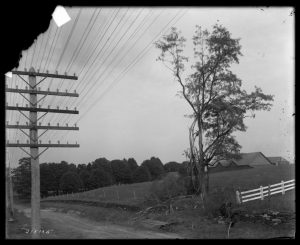
Powerful and unpredictable, lightning rejected easy classification, as it proved capable of reproducing its own image and transforming matter, often in dramatic and destructive ways. Late nineteenth-century newspapers abound with stories of injuries, property damage, and fatalities attributed to lightning. According to the Weather Bureau, from 1883 to 1892, lightning struck 2,335 barns, 104 churches, and 664 dwellings, and killed approximately 200 people annually in the United States.27 Jennings’ lightning photos visually conveyed this awesome power as bright streaks that slash across the photographic plate, destabilizing the viewer’s sense of perspective. In a photograph of “ribbon lightning” (see fig. 5), for example, the outline of a tree or bush in the upper left corner provides the only indicator of a surrounding landscape. Only Jennings’ scrawling handwriting underneath the image alerts the viewer to the correct orientation of the photograph. In his scrapbook, Jennings noted that this particular discharge struck and fired a barn two miles away, reminding the viewer of the harmful potential of his subject. Jennings was well aware of the damaging power of natural forces that persistently thwarted human intervention; he recorded the twisted, exploded forms of lightning-struck trees (fig. 6) and documented the devastating aftermath of the Johnstown Flood in 1889, caused by the failure of the South Fork Dam in Southwestern Pennsylvania.
Beyond its damaging powers and the visual evidence of its violence, lightning invited direct comparison to artists through its perceived ability to produce photographic effects, imprinting images of immediate surroundings through a process termed keraunography.28 The most sensational report of this occurrence took place in Bath in 1812, when six sheep killed by lightning were sheared to reveal an imprint of the local landscape on their skin. In 1883, lightning struck a boy standing by a yew tree in Berwickshire, England, leaving an impression on his arm evocative of tree branches.29 When describing his photographic practice, Jennings admitted that “lightning must paint its own likeness,” echoing the insistence of William Henry Fox Talbot (1800-1977) several decades earlier that photographs are “impressed by Nature’s hand.”30 In one 1890 Philadelphia Record article, Jennings recalled an instance when after a startlingly close lightning flash, he “found he had a fine negative of his old friend, only the glass plate was cracked almost all the way across,” as if lightning had intervened directly in the photographic process.31 Jennings also expressed a desire to “put on permanent record Franklins’ experiment,” by flying a kite from a window of a laboratory and allowing a spark to strike a photographic plate from the suspended key, thus permitting “Jove to write his own autograph.”32
The unruly, elusive qualities of lightning, which destroyed property and lives, resisted the organizing impulses of the Royal Meteorological Society and photographers like Jennings, and wrote its own autograph in blazing light also colored public reactions to emergent electric lighting that was making its grand debut in American cities. A handful of Philadelphia institutions tentatively adopted electric light in the late 1870s. John Wanamaker, Jennings’ previous employer, purchased twenty-eight Brush arc lamps to light his Grand Depot in 1878. These lamps, using a technology invented and patented by the Brush Electric Company of Cleveland, brightly lit Chestnut Street, one of the busiest thoroughfares of the city, beginning in 1881. Each arc lamp emitted light equal to three hundred gas jets and hung from forty feet high iron poles, strung together with wire that carried high-voltage direct current. By the mid 1890s, more than twenty electric companies, including Edison Electric Light Company, operated in Philadelphia, using different systems and supplying different currents.33
Philadelphians initially regarded electric lights with trepidation and anxiety as agents of potential danger that bordered on the supernatural. Urban residents and the press frequently drew from the language of thunderstorms and lightning bolts to articulate their unease about the unpredictable and unnatural qualities of electrical currents. In December of 1881, a fire at the Local Telegraph Company in Philadelphia was attributed to a crossing of telegraph wires with those used for electric lighting, creating what the Philadelphia Inquirer described as “an action like a lightning strike.”34 This fire sparked a flurry of concerned articles and letters in local newspapers, as the occurrence made “people fear the exposed electric light wires as much as they now admire the brilliance of electric illumination.”35 Considered unsightly, obstructive, and a nuisance when used for telegraphy, multiplying overhead wires were now also potentially lethal. One newspaper article, referring to the arc street lamps, wondered at how “the momentary flash that lighted up the clouds with a startling glare” was “made permanent and strung along above the pavements in a bead chain of brilliance.”36 Another article concluded, “Heretofore the expression ‘captive lightning,’ as applied to electric apparatus, has been a figure of speech, now it is an actual fact; and electricity must be put in the same category with steam and fire, as an excellent servant to man, but a terrible fiend if permitted to escape from his control.”37 The press frequently described electricity as “condensed,” “chained,” or “captive” lightning, phrases that both celebrated man’s victory over a powerful, natural energy, but also implied an uneasy containment with destructive potential.38 In his photograph of a lightning-struck tree mentioned earlier (see fig. 6), Jennings paired the splintered remains of the tree with the erect form of a utility pole and electrical wires (see fig. 6), a couple of which visually intersect the top left branches. This juxtaposition suggests a close association with the electricity running through the wires and the atmospheric electricity that caused the arboreal damage. Electric lights redefined lightning as well: at least one article described the subjects of Jennings’ photographs as “natural electricity,” meandering in their wavy course across the sky.39
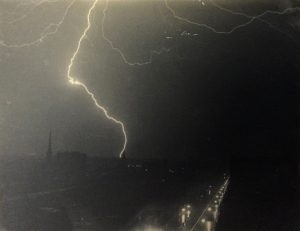
Jennings combined illumination by both chained and natural lightning in one photograph taken from an office window on the sixth floor of Broad Street Station in Philadelphia (fig. 7). This 1896 image features a vertical discharge of lightning with a “knotted” effect spreading its tentacle arms above Market Street. Ordered car headlights and electric street lamps, which by then were an increasingly common and accepted sight in the city, additionally light the street below. One Philadelphia newspaper reproduced the image, designating it the “Best Picture of Lightning Ever Taken.”40 For the newspaper reader, such an image likely recalled an uneasy link between the two forms of electricity—unleashed and tamed, magnificent and mundane—even as residents became more comfortable with the urban infiltration of electric lights. While Philadelphia residents both wondered and worried over the “captive lighting” transforming their streets and public spaces in the 1880s and 1890s, Jennings’ images continued to remind viewers of the unruly qualities of electricity, as it resisted photographic classification and claims of objectivity, asserting its own material force.
Acknowledgements
I would like to thank Ellery Foutch and Hélène Valance for inviting me to participate in their CAA panel and this special issue of Panorama. Thoughtful comments from them, Catherine Holochwost, and Shana Klein on earlier drafts have greatly expanded my thinking about lightning photography. I also wish to express my gratitude to the staff at the Franklin Institute and the Library Company of Philadelphia, especially John Alviti, Susannah Carroll, and Nicole Joniec, for their generous assistance with this research. I conducted a significant portion of this research as a National Endowment of Humanities Post-doctoral Fellow at the Library Company of Philadelphia in the fall of 2015 and I am very grateful for the support of these institutions.
DOI: https://doi.org/10.24926/24716839.1535
PDF: LTI – Capturing Jove
Notes
- W. N. Jennings, “Lightning Photography,” Scientific American 53, no. 10 (September 5, 1885): 149. ↵
- The Daily News (Philadelphia), September 30, 1885. ↵
- For more on photography, science, and objectivity, see Jonathan Crary, Techniques of the Observer: On Vision and Modernity in the Nineteenth Century (Cambridge, MA: MIT Press, 1990); Jennifer Tucker, “Photography as Witness, Detective, and Imposter: Visual Representation in Victorian Science,” in Victorian Science in Context, ed. Bernard V. Lightman (Chicago: University of Chicago Press, 1997), 378–408; Michael Leja, Looking Askance: Skepticism and American Art from Eakins to Duchamp (Berkeley: University of California Press, 2004); Jennifer Tucker, Nature Exposed: Photography as Eyewitness in Victorian Science (Baltimore: Johns Hopkins University Press, 2005); and Lorraine Daston and Peter Galison, Objectivity (New York: Zone Books, 2007). ↵
- “Lightning Flashes,” The Youth’s Companion 63, no. 41 (September 18, 1890): 485. This article, included in his “Jove’s Autograph” Scrapbook, is most likely by Jennings even though it is unattributed. William Nicholson Jennings, “Jove’s Autograph” Scrapbook, n.p., The Franklin Institute, Philadelphia. ↵
- Ibid. ↵
- Hollis Clayson, Electric Paris: The Visual Cultures of the City of Light in the Era of Thomas Edison (Chicago: University of Chicago Press, forthcoming); Hélène Valance, Nuits Américaines. L’art Du Nocturne Aux Etats-Unis, 1890–1917 (Paris: Presses de l’Université Paris-Sorbonne, 2015). Kate Flint has also investigated photographs of lightning in her research on the employment of romantic metaphors of divine illumination by promoters of flash photography. Kate Flint, “‘More Rapid than the Lightning’s Flash’: Photography, Suddenness, and the Afterlife of Romantic Illumination,” European Romantic Review 24, no. 3 (2013): 369–83. For an close analysis of lightning represented as both a divine force and a rational power that can be controlled by human art in the Enlightenment, see Michael Gaudio, “Magical Pictures; of Observations on Lightning and Thunder, Occasion’d by a Portrait of Dr. Franklin,” in Picturing, ed. Rachael Z. DeLue, Terra Foundation Essays 1 (Chicago: Terra Foundation for American Art, Chicago, distributed by University of Chicago Press, 2016), 84–113. ↵
- Jane Bennett, Vibrant Matter: A Political Ecology of Things (Durham, NC: Duke University Press, 2010), viii. See also Bruno Latour, Politics of Nature: How to Bring the Sciences into Democracy (Cambridge, MA: Harvard University Press, 2004); Timothy Morton, The Ecological Thought (Cambridge, MA: Harvard University Press, 2010); and Timothy Morton, Hyperobjects: Philosophy and Ecology After the End of the World (Minneapolis, MN: University of Minnesota Press, 2013). ↵
- Bennett, Vibrant Matter, 28. ↵
- Harry Silcox provides a biographical account of Jennings’ life in Harry C. Silcox, Jennings’ Philadelphia: The Life of Philadelphia Photographer William Nicholson Jennings (1860–1946) (Holland, PA: Brighton Press, 1993). ↵
- Jennings, “Jove’s Autograph” Scrapbook, 2. ↵
- Emphasis is original. James Nasmyth, “On the Form of Lightning,” in Report of the Twenty-Sixth Meeting of the British Association for the Advancement of Science (London: James Murray, 1857), 14. ↵
- Jennings explained, “the prepared plate was put in, and turned to the quarter of the sky from which the flash would probably come. But the lightnings, no more tamed than in the days of Job, will not come at our bidding, and say unto us, ‘Here we are.’” “A Flash of Lightning,” The Youth’s Companion 59, no. 35 (September 2, 1886): 332. This article, like the one cited in note 4, is also unattributed, but more than likely written by Jennings due to its inclusion in his “Jove’s Autograph” Scrapbook. ↵
- Jennings, “Jove’s Autograph” Scrapbook, n.p. ↵
- Tucker, Nature Exposed, 144; Dolores A. Kilgo, Likeness and Landscape: Thomas M. Easterly and the Art of the Daguerreotype (St. Louis: Missouri Historical Society Press, 1994). ↵
- According to an account in the French journal La Nature, republished in Popular Science Monthly, the German photographer Robert Haensel used sensitive gelatin-bromide plates, activated by the flash itself, to photograph lightning on July 6, 1883, two years before Scientific American published Jennings’ work. Gaston Tissandier, “Photographing a Streak of Lightning,” The Popular Science Monthly 24 (April 1884): 752–54. See also Ralph Abercromby, “On the Photographs of Lightning Flashes,” Quarterly Journal of the Royal Meteorological Society 14 (1888): 226–34; William Marriott, “Application of Photography to Meteorological Phenomena,” Quarterly Journal of the Royal Meteorological Society 16 (1890): 146–52. ↵
- Jennings, “Jove’s Autograph” Scrapbook, n.p. ↵
- William H. Wahl, “Proceedings of the Stated Meeting, Held Wednesday, May 18, 1892,” Journal of the Franklin Institute 133, no. 6 (June 1892): 505. ↵
- William N. Jennings, “Joves Autograph,” lecture notes in “Assorted Writings” Scrapbook, The Library Company of Philadelphia (P.2010.12.115). ↵
- For more in-depth studies of the institutionalization of nineteenth-century meteorological science and the field’s collection and deployment of visual data, see James Rodger Fleming, Meteorology in America, 1800-1870 (Baltimore: Johns Hopkins University Press, 1990); Mark S. Monmonier, Air Apparent: How Meteorologists Learned to Map, Predict, and Dramatize Weather (Chicago: University of Chicago Press, 1999); and Katherine Anderson, Predicting the Weather: Victorians and the Science of Meteorology (Chicago: University of Chicago Press, 2005). ↵
- Alexander McAdie, “Tracing the Path of Flash of Lightning by Photography,” American Journal of Photography, no. 203 (November 1896): 486. ↵
- Weather reporting previously depended upon a fragmented, voluntary observation network, overseen by the Smithsonian, which relied on telegraphy to transmit weather observations recorded by volunteer stations throughout the United States. Joseph O. Galway, “Early Severe Thunderstorm Forecasting and Research by the United States Weather Bureau,” Weather and Forecasting 7, no. 4 (December 1992): 564–87. ↵
- Tucker, Nature Exposed, 126–58. ↵
- According to Inwards, only Nasmyth and Joseph Mallord William Turner represented lightning correctly. Richard Inwards, “Weather Fallacies,” Quarterly Journal of the Royal Meteorological Society 21, no. 94 (April 1895): 56–57. ↵
- “The Soudan,” The Philadelphia Inquirer, January 11, 1891; Jennings, “Jove’s Autograph” Scrapbook, n.p. ↵
- Abercromby, “On the Photographs of Lightning Flashes.” ↵
- Ibid., 226. See also Jimena Canales, A Tenth of a Second: A History (Chicago: University of Chicago Press, 2009), 117–53. ↵
- Alexander McAdie, Protection from Lightning, US Department of Agriculture, Weather Bureau Circular of Information (Washington, DC: Weather Bureau, 1894), 6–8. ↵
- Keraunography translates from Greek as lightning writing or representation. ↵
- The Royal Meteorological Society displayed a photograph of the boy’s arm with other evidence of lightning-caused destruction, including the shredded clothes of two men who were struck by lightning at Hampstead Heath in 1888. G. J. Symons, “A ‘Lightning Figure’ Photographed,” Symons’s Monthly Meteorological Magazine 18 (July 1883): 81–84. For more nineteenth-century accounts of keraunography, see Marriott, “Application of Photography to Meteorological Phenomena”; Jeremy Broome, “Lightning,” The Strand Magazine 13, no. 73 (January 1897): 41–49. ↵
- For Jennings’ quote, see “A Flash of Lightning.” Henry Fox Talbot, The Pencil of Nature (New York: De Capo Press, 1969), n.p. ↵
- Newspaper clipping marked “Phila Record, 1890,” in Jennings, “Jove’s Autograph” Scrapbook, n.p. ↵
- Jennings, “Jove’s Autograph” Scrapbook, n.p. ↵
- Due to heightened scrutiny by city officials profiting from other electric companies, the Edison Electric Light Company did not begin operation until 1889. Nicholas B. Wainwright, History of the Philadelphia Electric Company, 1881–1961 (Philadelphia: Philadelphia Electric Company, 1961), 1–28. ↵
- “Fire by Electric Wires,” The Philadelphia Inquirer, December 26, 1881. ↵
- “(Local Telegraph Company),” The Philadelphia Inquirer, December 28, 1881. ↵
- “Electricity: Some Prominent Features of the Approaching Exhibition,” The Philadelphia Inquirer, July 5, 1884. ↵
- “(Local Telegraph Company).” As historian Linda Simon has explained, “Harnessing electricity seemed an act of transgression against the power of nature.” Linda Simon, Dark Light: Electricity and Anxiety from the Telegraph to the X-Ray (Orlando: Harcourt, 2004), 5. ↵
- See, for example, “Artificial Lightning. Insurance Companies Alarmed. Probability of Their Refusal to Take Risks, Enhanced by Electric,” The Philadelphia Inquirer, February 4, 1882; “A New Goddess (Advertisement),” The Philadelphia Inquirer, September 29, 1884. ↵
- “Lightning: How It Appears on the Photographic Plate,” Journal of Education 35, no. 15 (April 14, 1892): 229. ↵
- “Best Picture of Lightning Ever Taken, Secured by Local Man,” unattributed newspaper clipping, in Jennings, “Jove’s Autograph” Scrapbook, n.p. ↵
About the Author(s): Laura Turner Igoe is at Harvard University Art Museums

